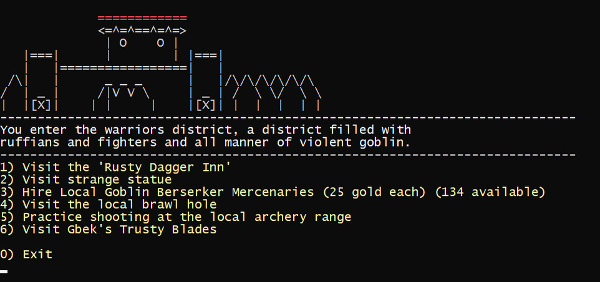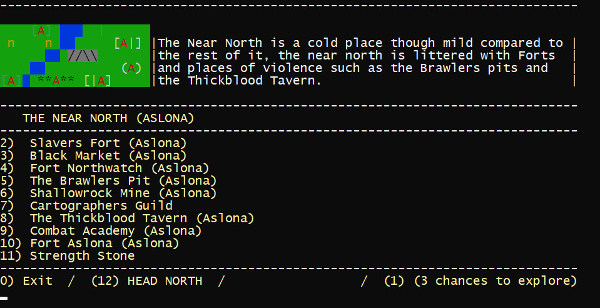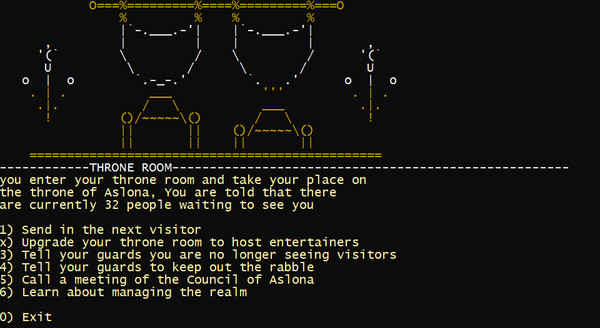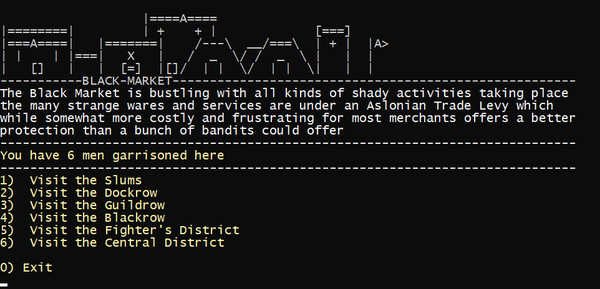Wastelander404
Arcane

- Joined
- Feb 19, 2019
- Messages
- 306
Thanks! Hope you do get a chance to play it 



Check out this new article written on Warsim's 75 million races, https://medium.com/@huw2k8/the-indie-game-with-75-million-fantasy-races-inside-it-b9ee6ddf1102






* New drink - https://i.imgur.com/M8TMR5h.png






















Interview: Warsim’s Huw Millward
on October 16, 2019
With an old-school look and a kingdom management mandate, Warsim: The Realm of Aslona includes procedural content with yesteryear presentation. I find an odd sense of satisfaction in the control and exploration of a largely text-based world populated by ASCII art, and I took the opportunity to pick Huw Millward’s brain on the nature of his game.
Erik Meyer: At a time when so many games focus on the advantages provided by modern game engines, Warsim uses ASCII graphics and text-based inputs. From a game development and overall look standpoint, how did you arrive at this style of presentation?
Huw Millward: That’s a good question actually; it wasn’t really a conscious decision, as the game was never intended to be a game. I was playing around practicing my programming in C++ and at the time had little experience with the graphical side of programming. Over time, this little project grew into Warsim, and I never looked back. The ASCII graphic style definitely hinders the game’s ability to ever reach a more mainstream indie audience, but it still does the job I think!

EM: As a design challenge, what do you see as the nuts and bolts of a kingdom management game? Where have you had to narrow your scope, and what kinds of tasks/choices do you see as essential to the overall experience?
HM: I have tried to take inspiration from other games but do my own thing at the same time. One issue that has been deeply entrenched in Warsim’s development philosophy for a long time has been to include and even significantly glorify the parts of ruling kingdoms in video games that are often overlooked: entertainment and personal choice. In many games where you play as a ruler of a kingdom, you find yourself limited only to the option of conquest, but what if you want to viciously pursue peace so you can instead spend your time watching men throw axes at each other to the death, or to witness a few gnomes battling it out with their insults, or perhaps to go and get drunk at the nearby goblin town for their celebrations. I’ve tried hard to address what I feel many games are lacking and made doing what you want the center point of Warsim development, because as the king of some weird fantasy kingdom, war should only be part of the fun.
EM: You’ve noted the procedural generation system for fantasy races, with unique information ranging from birth rate to specific faces and battle stats. Within your work, how do you see procedural content balancing against specific, handcrafted content? For example, many sidescroller games construct levels carefully, piece by piece, to scale difficulty and challenges as players increase in skill. What do you see as the strength of these kinds of randomized elements, and how do you see them fitting into the overall picture?
HM: I’ve thought about this a lot; handcrafted content almost always wins against procedural content for its depth, but when this race system was first added, it was able only to generate a handful of races, and I worked hard to add to the various systems to make sure each felt and played a little differently. In the years since the feature was added, and with the help of some of the game’s fans, the race system has been aggressively expanded, now boasting over 75 million random races with a whole myriad of different traits and visual differences. Now it’s almost a given that every single race seen by a player will only be seen by them, and I think that’s something special. Another perhaps more personal reason I enjoy procedural generation is as the developer of this game, despite 4+ years spent on it, I am still constantly met with things I’ve not seen before.

EM: I see a great deal of choice available to players; they can rule in many different ways (benevolent, iron-fisted, warlord, etc), go to taverns, attend the Arena, manage the throne room, and arrange festivals (among other things). Given the interface through which gamers experience the world, what do you see unifying these varied options? How do you keep things open-ended yet personal, varied yet unique?
HM: The game’s options follow a similar layout but are of course adapted based on where you are. The system is fairly simple with its numerical options but overall it allows for quite a vast number of outcomes and things you can do, while not overwhelming the players with 50+ hotkeys they need to remember.
EM: To put it simply, the game includes silly elements (unconventional naming, quirky outcomes) and has fun with a lot of fantasy world ideas. Warsim also creates a great deal of information per turn for players, and I’m curious about how you see engagement with information relating to the kinds of information presented. What kinds of details do you see your audience finding interesting? What pushes the needle forward?
HM: There are lots of things that I get good feedback on surrounding the silly elements of the game. It was never intended to be a comedic game, but I think over time whimsical humorous additions to the game have pushed it in that direction. I think it helps give the game and the world more personality. Sometimes the procedural content gets shared around; one player found a rather amusing snake creature, which ended up being added to the game world permanently. I personally add things that I find amusing or laugh at, because I enjoy the game myself. It’s easy designing it for me and has worked well so far.

EM: To look back at the tradition you’re drawing on and precursors to your work, what is it about MUDs and other text-based adventures that captured so many imaginations in the ’80s and early ’90s? Do you see a theater of the mind quality to these games, or is it the allure of the unknown that draws players in?
HM: I’m fairly ignorant of the MUDs of the ’80s and ’90s, so Warsim’s similarities to them is purely coincidental. From what I understand, though, these games played like interactive books with a portion of the fun being filled in by your imagination, and the same is definitely true for Warsim. I feel a lot less limits than some AAA developers are restricted by, so some of the stuff that I’m able to do with Warsim is different.
EM: In terms of ruling tactics and strategies, what kinds of play styles do you see emerging, in broad strokes? In developing Warsim, how do you design for and reward truly diverse interactions as opposed to powergaming patterns?
HM: There are quite a few ways to play; normally, I’ll develop new ways to play by trying to play differently and think differently in game and then hitting roadblocks or thinking ‘Man it would be better if I could bully these miners into giving me a tribute instead of just killing them off’, so it gets added. I’m also always open to the ideas mentioned by fans of the game which has definitely expanded and shaped the game in ways I would likely not have thought about. One player asked for the ability to destroy all of the buildings in the game world, and in the update that followed, 40+ of the structures were made destroyable with the relevant consequences.

EM: You’re still adding to the project, so what do you see at the horizon? Similarly, now that you’re getting public feedback, what do your benchmarks and development cycle look like, moving ahead?
HM: It’s been a bit eclectic so far. I’ve got a list of around 800 ideas and plans for the game from myself and the fans of the game that I am attempting to slowly cut down. I don’t have an end in sight yet for the game’s development, and I don’t intend to rush it, but I am trying to isolate areas that are most in need of rework or further development in an attempt to get the game into a complete state before I go off on too many development tangents. I do plan on getting it out of early access someday though!










